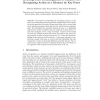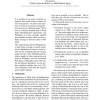250 search results - page 14 / 50 » Learning Probabilistic Models of Word Sense Disambiguation |
EMNLP
2009
14 years 9 months ago
2009
The work presented in this paper explores a supervised method for learning a probabilistic model of a lexicon of VerbNet classes. We intend for the probabilistic model to provide ...
CAISE
2004
Springer
15 years 5 months ago
2004
Springer
The so-called Semantic Web vision will certainly benefit from automatic semantic annotation of words in documents. We present a method, called structural semantic interconnections ...
130
click to vote
ACCV
2010
Springer
14 years 7 months ago
2010
Springer
Abstract. We propose a methodology for recognizing actions at a distance by watching the human poses and deriving descriptors that capture the motion patterns of the poses. Human p...
103
click to vote
ACL
2010
14 years 10 months ago
2010
Is it possible to use sense inventories to improve Web search results diversity for one word queries? To answer this question, we focus on two broad-coverage lexical resources of ...
102
click to vote
SAC
2009
ACM
15 years 6 months ago
2009
ACM
Incorporating background knowledge into data mining algorithms is an important but challenging problem. Current approaches in semi-supervised learning require explicit knowledge p...


